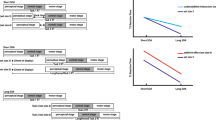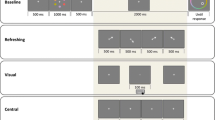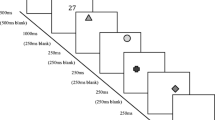Abstract
We studied parallel processes: visual processes with the prosaccade, the no-saccade and the antisaccade task on the one hand and memory processes with the random tap task on the other hand. The random tap task is believed to be a pure interference task for the central executive component of working memory. The number of saccadic errors was found not to be influenced by taxing the central executive, while the latency times were significantly increased both in the prosaccade and in the antisaccade task. The effect seen in the antisaccade task was expected since it is a non-automatic activity under central executive control. Because the prosaccade task is an automatic activity, an effect of central executive load was not expected. As an explanation for our findings, we postulate that the prosaccade task is brought under willed control of the central executive.
Similar content being viewed by others
References
Stanton GB, Goldberg ME, Bruce CJ. Frontal eye field efferent in the macaque monkey. J Comp Neurol 1988; 271: 473–506.
Segraves MA. Activity of monkey frontal eye field neurons projecting to oculomotor regions of the pons. J Neurophysiol 1992; 68: 1967–1985.
Pierrot-Deseilligny C, Rivaud S, Gaymard B, Müri R, Vermersch A-I. Cortical control of saccades. Ann Neurol 1995; 37: 557–567.
Baddeley AD, Hitch GJ. Working memory. In: Bower GH, ed. The psychology of learning and motivation. New York: New York Academic Press, 1974, vol 8: 47–89.
Baddeley AD. Human memory: Theory and practice. London: Lawrence Erlbaum Associates, 1990: 117–141.
Norman DA, Shallice T. Attention to action: Willed and automatic control of behaviour. In: Davidson RJ, Schwarts GE, Shapiro D, eds. Consciousness and selfregulation. Advances in research and theory. New York: Plenum Press, 1986, vol 4: 1–18.
Roberts RJ, Hager LD, Heron C. Prefrontal cognitive processes: Working memory and inhibition in the antisaccade task. J Exp Psychol 1994; 123: 374–393.
Vandierendonck A, De Vooght G, Van der Goten K. Does random time interval gener-ation interfere with working memory executive functions? Eur J of Cognitive Psychol 1998; 10: 413–442.
Maes J, De Ridder K. Evalsac program. University of Ghent, Belgium, 1994.
Schoonjans F, Zalata A, Depuydt CE, Comhaire FH. MedCalc: A new computer program for medical statistics. Comput Methods Programs Biomed 1995; 48: 257–262.
Baddeley AD. The capacity for generating information by randomization. Q J Exp Psychol 1966; 18: 119–129.
Glanzer M, Dorfman D, Kaplan B. Short-term storage in the processing of text. Journal of Verbal Learning and Verbal Behavior 1981; 20: 656–670.
Gilhooly KJ, Logie RH, Wetherick NE, Wynn V. Working memory and strategies in syllogistic-reasoning tasks. Mem-Cognit 1993; 21: 115–124.
Author information
Authors and Affiliations
Rights and permissions
About this article
Cite this article
Claeys, K., Crevits, L., Stuyven, E. et al. Parallel visual and memory processes. Doc Ophthalmol 95, 349–358 (1998). https://doi.org/10.1023/A:1001816709627
Issue Date:
DOI: https://doi.org/10.1023/A:1001816709627




